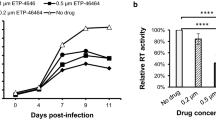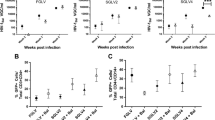Abstract
The hematopoietic failure in the majority of patients with progressive HIV infection is further aggravated by virustatic agents like azidothymidine. As an alternative therapeutic attempt, three derivatives of an antisense oligodeoxynucleotide (ODN) against the splice acceptor site of the tat gene have been shown to inhibit HIV replication in vitro. This study was aimed at examining whether these agents are toxic to the hematopoietic progenitor cells. To this end, bone marrow cells from HIV-positive and healthy persons were depleted from adherent cells to eliminate fibroblasts. In further experiments, the cells were additionally enriched for CD34-positive hematopoietic progenitor cells or were depleted fromδTCS-1-positive T lymphocytes. At concentrations of 1.25–10 ΜM, the three antisense ODN did not inhibit any erythrocyte or granulocyte-monocyte colony growth from CD34-positive cells, either from the HIV-positive or from the HIV-negative cohort. In contrast to azidothymidine, which served as inhibitory control, a significant increase of colony growth was seen after depletion of fibroblasts, ofδTCS-1-positive cells, or without cell separation. In conclusion, the three oligodeoxynucleotides do not exert any hematotoxic effect but do increase colony formation from low-density bone marrow cells in vitro and could therefore be useful in future clinical studies.
Similar content being viewed by others
References
Zon LI, Groopman JE (1988) Hematologic manifestations of the human immunodeficiency virus (HIV). Semin Hematol 25:208–218
Ganser A, Ottmann OG, von Briesen H, Völkers B, Rübsamen-Waigmann H, Hoelzer D (1990) Changes in the haematopoietic progenitor cell compartment in the acquired immunodeficiency syndrome. Res Virol 141:185–193
Mitsuya H, Broder S (1987) Strategies for antiretroviral therapy in AIDS. Nature 325:773–778
Fischl MA, Richman DD, Grieco MH, Gottlieb MS, Volberding PA, Laskin OL, Leedom JM, Groopman JE, Mildvan D, Schooley RT, Jackson GG, Durack DT, Phil D, King D, AZT Collaborative Working Group (1987) The efficacy of azidothymidine (AZT) in the treatment of patients with AIDS and AIDS-related complex. N Engl J Med 317:185–191
Richman DD, Fischl MA, Grieco MH, Gottlieb MS, Volberding PA, Laskin OL, Leedom JM, Groopman JE, Mildvan D, Hirsch MS, Jackson GG, Durack DT, Phil D, Nusinoff-Lehrman S, AZT Collaborative Working Group (1987) The toxicity of azidothymidine (AZT) in the treatment of patients with AIDS and AIDS-related complex. N Engl J Med 317:192–197
Sommadossi JP, Carlisle R (1987) Toxicity of 3′-azido-3′deoxythymidine and 9-(1,3-dihydroxy-2-propoxymethyl)guanine for normal human hematopoietic progenitor cells in vitro. Antimicrob Agents Chemother 31:452–454
Daniak N, Worthington M, Riordan MA, Kreczko S, Goldman L (1988) 3′-Azido-3′-deoxythymidine (AZT) inhibits proliferation in vitro of human haematopoietic progenitor cells. Br J Haematol 69:299–304
Ganser A, Greher J, Völkers B, Staszeweski S, Hoelzer D (1989) Inhibitory effect of azidothymidine, 2′-3′-dideoxyadenosine, and 2′-3′-dideoxycytidine on in vitro growth of hematopoietic progenitor cells from normal persons and from patients with AIDS. Exp Hematol 17:321–325
Yarchoan R, Klecker RW, Weinhold KJ, Markham PD, Lyerly HK, Durack DT, Gelmann E, Nusinoff-Lehrman S, Blum RM, Barry DW (1986) Administration of 3′-azido-3′-deoxythymidine, an inhibitor of HTLV-III/LAV replication, to patients with AIDS or AIDS-related complex. Lancet 1:575
Walker BD, Kowalski M, Goh WC, Kozarsky K, Krieger M, Rosen C, Rohrschneider L, Haseltine WA, Sodroski J (1987) Inhibition of human immunodeficiency virus syncytium formation and virus replication by castanospermine. Proc Natl Acad Sci USA 84:8120–8124
Schröder HC, Wenger R, Rottmann M, Müller WEG (1988) Alteration of nuclear (2′-5′)oligoriboadenylate synthetase and nuclease activities preceding replication of human immunodeficiency virus in H9 cells. Biol Chem Hoppe Seyler 369:985–995
Schröder HC, Wenger R, Kuchino Y, Müller WEG (1989) Modulation of nuclear matrix-associated (2′-5′)oligoadenylate metabolism and ribonuclease L activity in H9 cells by human immunodeficiency virus. J Biol Chem 264:5669–5673
Montefiori DC, Sobol RW, Li SW, Reichenbach NL, Suhadolnik RJ, Charubala R, Pfleiderer W, Modliszewski A, Robinson WE, Mitchell WM (1989) Phosphorothioate and cordycepin analogous of 2′,5-oligoadenylate: inhibition of human immunodeficiency virus type 1 reverse transcriptase and infection in vitro. Proc Natl Acad Sci USA 86:7191–7194
Renneisen K, Leserman L, Matthes E, Schröder HC, Müller WEG (1990) Inhibition of expression of human immunodeficiency virus-1 in vitro by antibody-targeted liposomes containing antisense RNA to the env region. J Biol Chem 265:16337–16342
Goodchild J, Agrawal S, Civeira MP, Sarin PS, Sun D, Zamechnik PC (1988) Inhibition of human immunodeficiency virus replication by antisense oligodeoxynucleotides. Proc Natl Acad Sci USA 85:5507–5511
Matsukura M, Zon G, Shinozuka K, Robert-Guroff M, Shimada T, Stein CA, Mitsuya H, Wong-Staal F, Cohen JS, Broder S (1989) Regulation of viral expression of human immunodeficiency virus in vitro by an antisense phosphorothioate oligodeoxynucleotide against rev (art/trs) in chronically infected cells. Proc Natl Acad Sci USA 86:4244–4248
Zauli G, Davis BR, Re MC, Visani G, Furlini G, La Placa M (1992) tat Protein stimulates production of transforming growth factor-Β1 by marrow macrophages: a potential mechanism for human immunodeficiency virus-1-induced hematopoietic suppression. Blood 80:3036–3043
Viscidi RP, Mayur K, Lederman HM, Frankel AD (1989) Inhibition of antigen-induced lymphocyte proliferation by tat protein from HIV-1. Science 246:1606–1608
Ensoli B, Barillari G, Zaki Salahuddin S, Gallo RC, WongStaal F (1990) Protein of HIV-1 stimulates growth of cells derived from Kaposi's sarcoma lesions of AIDS patients. Nature 345:84–86
Majumdar C, Stein C, Cohen J, Broder S, Wilson S (1989) HIV reverse transcriptase stepwise mechanism: phosphorothioate oligodeoxynucleotide as primer. Biochemistry 28:1340–1346
Stein C, Neckers L, Nair B, Mumbauer S, Hoke G, Pal R (1991) Phosphorothioate oligodeoxynucleotide interferes with binding of CD4 to gp 120. J AIDS 4:686–693
Geissler RG, Ottmann OG, Kleiner K, Mentzel U, Bickelhaupt A, Hoelzer D, Ganser A (1993) Decreased hematopoietic colony growth in long-term bone marrow cultures of HIV-positive patients. Res Virol 144:69–73
Geissler RG, Ganser A, Rossol R, Ottmann OG, Klein AS, Mentzel U, Hoelzer D (1992) Inhibition of bone marrow-derived hematopoietic colony formation by a delta-TCS-positive gamma-delta-T-cell-population in patients with AIDS. Exp Hematol 20:733
Ratner L, Haseltine W, Patarca R, Lidvak KJ, Stracich B, Josephs SF, Doran ER, Rafalski JA, Whitehorn EA, Baumeister K, Ivanoff L, Petteway SR, Pearson ML, Lautenberger JA, Papas TS, Ghrayeb J, Chang NT, Gallo RC, Wong-Staal F (1985) Complete nucleotide sequence of the AIDS virus, HTLV-III. Nature 313:277–284
Stein CA, Subasinge C, Shinozuka K, Cohen JS (1988) Physicochemical properties of phosphorothioate oligodeoxynucleotides. Nucleic Acids Res 16:3209–3221
Letsinger RL, Zhang GR, Sun DK, Ikeuchi T, Sarin PS (1989) Cholesteryl-conjugated oligonucleotides: synthesis, properties, and activity as inihibitors of replication of human immunodeficiency virus in cell culture. Proc Natl Acad Sci 86:6553–6556
Mag M, Muth J, Lücking S, Bliesert L, Engels J (1991) HIV inhibition by antisense oligodeoxynucleotides. Nucleosides Nucleotides 10:627–629
Agrawal S, Ikeuchi T, Sun D, Sarin PS, Konopka A, Maizel J, Zamechnik PC (1989) Inhibition of human immunodeficiency virus in early infected and chronically infected cells by antisense oligodeoxynucleotides and their phosphorothioate analogs. Proc Natl Acad Sci USA 86:7790–7794
Uhlmann E, Peyman A (1990) Antisense oligonucleotides: a new therapeutic principle. Chem Rev 90:543–584
Stein CA (1992) Antisense oligodeoxynucleotides — promises and pitfalls. Leukemia 10:967–974
Ottmann OG, Pelus LM (1988) Differential proliferative effects of transforming growth factor-Β on human hematopoietic progenitor cells. J Immunol 140:2661–2665
Ganser A, Carlo-Stella C, Greher J, Völkers B, Hoelzer D (1987) Effect of recombinant interferons alpha and gamma on human bone marrow-derived megakaryocytic progenitor cells. Blood 70:1173–1179
Louache F, Henri A, Bettaieb A, Oksenhendler E, Raguin G, Tulliez M, Vainchenker W (1992) Role of human immunodeficiency virus replication in defective in vitro growth of hematopoietic progenitors. Blood 80:2991–2999
Chang HK, Gendelman R, Lisziewicz J, Gallo RC, Ensoli B (1994) Block of HIV-1 infection by a combination of antisense tat RNA and TAR decoys: a strategy for control of HIV-1. Gene Ther 1:208–216
Lisziewicz J, Sun D, Metelev, Zamecnik P, Gallo RC, Agrawal S (1993) Long-term treatment of human immunodeficiency virus-infected cells with antisense oligonucletide phosphorothiates. Proc Natl Acad Sci USA 90:3860–3864
Kim SG, Suzuki Y, Nakashima H, Yamamoto N, Takaku H (1991) Phosphorothioate analogs of oligodeoxyribonucleotide: synthesis and activity as inhibitors of replication of human immunodeficiency virus. Biochem Biophys Res Commun 179:1614–1619
Iversen PL, Crouse D, Zon G, Perry G (1992) Binding of antisense phosphorothioate oligonucleotides to murine lymphocytes is lineage specific and inducible. Antisense Res Dev 223–233
Laurence J, Sikder SK, Kulkosky J, Miller P, Ts'o PO (1993) Induction of chronic human immunodeficiency virus infection is blocked in vitro by a methylphosphanate oligodeoxynucleoside targeted to a U3 enhancer element. J Virol 65:213–219
Balotta C, Lusso P, Crowley R, Gallo RC, Franchini G (1993) Antisense phosphorothioate oligodeoxynucleotides targeted to the vpr gene inhibit human immunodeficiency virus type 1 replication in primary human macrophages. J Virol 67:4409–4414
Bordier B, Helene C, Barr PJ, Litvak S, Sarih-Cottin L (1992) In vitro effects of antisense oligonucleotides on human immunodeficiency virus type 1 reverse transcriptase. Nucleic Acids Res 20:5999–6006
Stein CA, Cheng YC (1993) Antisense oligonucleotides as therapeutic agents — is the bullet really magical? Science 261:1004–1012
Maury G, El Alaoui A, Morvan F, Müller B, Imbach JL, Goody RS (1992) Template. Phosphorothioate oligonucleotide duplexes as inhibitors of HIV-1 reverse transcriptase. Biochem Biophys Res Commun 186:1249–1256
Morvan F, Porumb H, Degols G, Lefebvre I, Pompon A, Sproat BS, Rayner B, Malvy C, Lebleu B, Imbach JL (1993) Comparative evaluation of seven oligonucleotide analogues as potential antisense agents. J Med Chem 36:280–287
Author information
Authors and Affiliations
Rights and permissions
About this article
Cite this article
Geissler, R.G., Muth, J., Maurer, A. et al. Modified antisense oligodeoxynucleotides against the splice acceptor site of tat do not inhibit in vitro hematopoietic colony growth in HIV-positive patients. Ann Hematol 71, 89–95 (1995). https://doi.org/10.1007/BF01699252
Received:
Accepted:
Issue Date:
DOI: https://doi.org/10.1007/BF01699252




